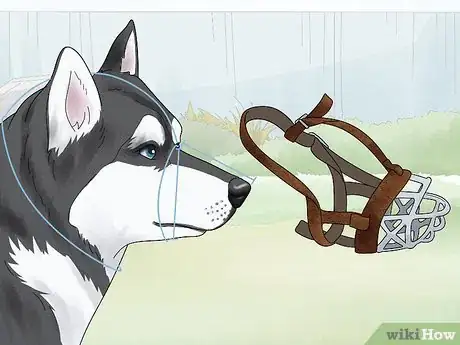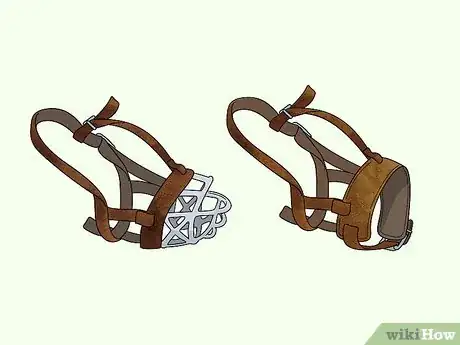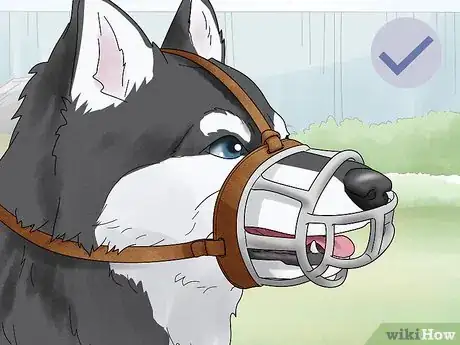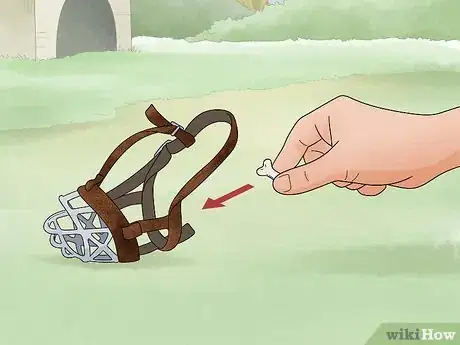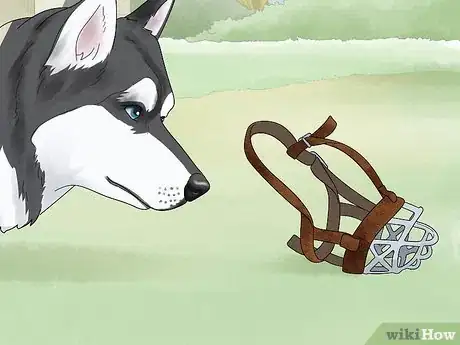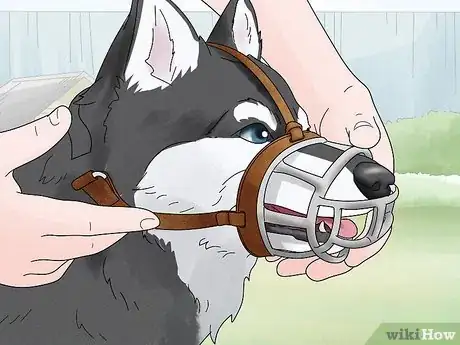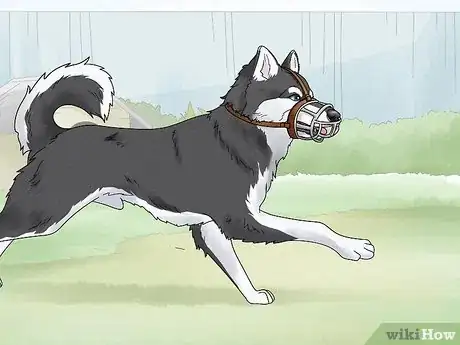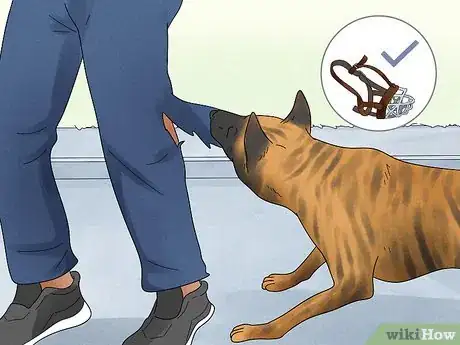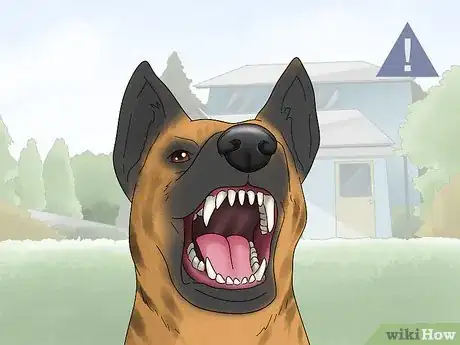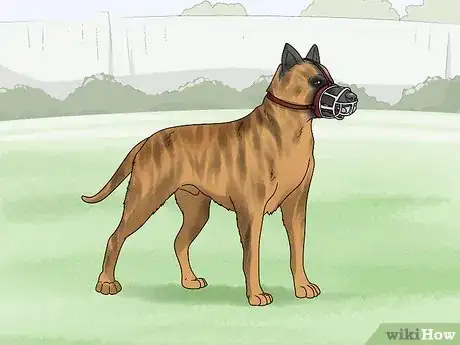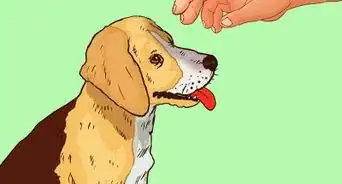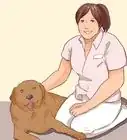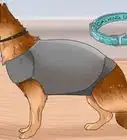This article was co-authored by Lauren Novack. Lauren Novack is a Certified Dog Behavior Consultant at Behavior Vets NYC where she helps fearful, anxious, and aggressive pets and their owners. She has completed coursework for her MS in Applied Behavior Analysis at Hunter College. Lauren’s research explores the intersection between training practices and animal welfare. She currently serves on the Editorial Advisory Board for Daily Paws and has appeared on Fox & Friends, Rachel Ray, and various news outlets with her dog Grayson.
This article has been viewed 19,178 times.
Using a muzzle can prevent your pup from picking up food from the ground, biting themselves when they have allergies, or biting others. Most animal behavior experts recommend using the muzzle for protection while the dog learns to deal with stimuli, not using it as punishment.
Steps
Introducing a Muzzle
-
1Find a muzzle that matches your dog's measurements. Most muzzles are labeled with two to four measurements. The first measurement is the circumference around the dog's mouth. The second number is the length from the tip of the nose to the back of the head. Some muzzles also measure the length from the tip of the nose to the point in between the dog's eyes, or from the point between a dog's eyes to the back of the skull.
-
2Decide on a type of muzzle. There are two types of muzzle design:
- Some muzzles still allow the dog to drink water and pant. These may not prevent all nips, but they should greatly reduce the danger.
- Some muzzles keep the dog's mouth shut completely. These should not be used for more than a few minutes. If left on longer, the dog could panic or overheat due to an inability to pant.
Advertisement -
3Test the muzzle's fit. Read the instructions for the muzzle and make sure you know how to put it on correctly. Make sure the muzzle fits loosely enough that your dog can still open their mouth to pant. There should be three straps on the muzzle to secure it so it can't be taken off.[1] The muzzle should cover at least 50–70% of the dog's mouth.
- If the dog's eyes are covered in any way, the muzzle is not the correct size or it's on upside-down, which is an easy mistake to make.[2]
- Let the dog attempt to remove the muzzle by rubbing its snout on the ground or using its paws to pull the muzzle off. If it succeeds, try a different size.
-
4Place treats at the bottom of the muzzle near the snout. Let your dog eat out of the muzzle. That way, it can start getting comfortable with it. Feed your pup their meals this way for a few days.[3]
-
5Present the muzzle to your dog without food in the bottom. Your dog will move into the muzzle in anticipation of eating. When they do that, give them a treat through the front of the muzzle. Back the muzzle off, then repeat.[4]
- Do this for a few days, as well.
-
6Attach the straps once your dog is comfortable. When your dog enthusiastically moves into the muzzle on their own, attach the straps, give the dog treats, and then take the muzzle off. Give your dog a few days to get used to this step, also.[5]
-
7Get the dog used to the muzzle. Go for a short walk, let the dog wear it around the house for a few minutes, or practice obedience training with the muzzle on. Get the dog used to the muzzle, or it may panic and become more aggressive when you try to use it in an urgent situation.
- Every time you put the muzzle on, leave it on for a bit longer as your dog acclimates to wearing it.[6]
Using the Muzzle as Protection
-
1Use a muzzle as a last resort. If your dog must be in a situation where they have previously bitten, they can't hurt anyone if they are muzzled. Identify the risky situations that have caused your dog to nip in the past and preemptively muzzle your dog whenever it's about to face these situations if they are unavoidable.
-
2Watch for warning signs. If you know your dog's warning signs before it nips, remove your pup from the situation. Signs of stress include a furrowed brow, averting eye contact, moving away, stiff body language, exposed teeth, raised hackles, and growling.[9]
- If you do need to muzzle your dog, it's best do it before you go into the situation that might make them feel stressed, while they're still calm.
-
3Have your dog wear the muzzle frequently so they're comfortable in it. Wearing a muzzle should be just as fun for your dog as any other trick you teach them. Ask your dog to put their muzzle on as often as you ask them to give you their paw or roll over. This should be fun and will keep up the positive association.[10]
Expert Q&A
-
QuestionHow do I get my dog comfortable with a muzzle?
 Lauren NovackLauren Novack is a Certified Dog Behavior Consultant at Behavior Vets NYC where she helps fearful, anxious, and aggressive pets and their owners. She has completed coursework for her MS in Applied Behavior Analysis at Hunter College. Lauren’s research explores the intersection between training practices and animal welfare. She currently serves on the Editorial Advisory Board for Daily Paws and has appeared on Fox & Friends, Rachel Ray, and various news outlets with her dog Grayson.
Lauren NovackLauren Novack is a Certified Dog Behavior Consultant at Behavior Vets NYC where she helps fearful, anxious, and aggressive pets and their owners. She has completed coursework for her MS in Applied Behavior Analysis at Hunter College. Lauren’s research explores the intersection between training practices and animal welfare. She currently serves on the Editorial Advisory Board for Daily Paws and has appeared on Fox & Friends, Rachel Ray, and various news outlets with her dog Grayson.
Certified Dog Behavior Consultant Start putting one on your dog when it's a puppy to help it get used to the muzzle.
Start putting one on your dog when it's a puppy to help it get used to the muzzle.
Warnings
- As with a leash, don't leave the muzzle on the dog if you cannot directly supervise the dog.⧼thumbs_response⧽
- When outfitting your dog with the muzzle, make sure that you don't put it on too loose or too tight. Your dog may be uncomfortable wearing a muzzle that is too tight.⧼thumbs_response⧽
References
- ↑ Lauren Novack. Certified Dog Behavior Consultant. Expert Interview. 23 February 2021
- ↑ Lauren Novack. Certified Dog Behavior Consultant. Expert Interview. 23 February 2021
- ↑ Lauren Novack. Certified Dog Behavior Consultant. Expert Interview. 23 February 2021
- ↑ Lauren Novack. Certified Dog Behavior Consultant. Expert Interview. 23 February 2021
- ↑ Lauren Novack. Certified Dog Behavior Consultant. Expert Interview. 23 February 2021
- ↑ Lauren Novack. Certified Dog Behavior Consultant. Expert Interview. 23 February 2021
- ↑ Lauren Novack. Certified Dog Behavior Consultant. Expert Interview. 23 February 2021
- ↑ Lauren Novack. Certified Dog Behavior Consultant. Expert Interview. 23 February 2021
- ↑ Lauren Novack. Certified Dog Behavior Consultant. Expert Interview. 23 February 2021
- ↑ Lauren Novack. Certified Dog Behavior Consultant. Expert Interview. 23 February 2021
